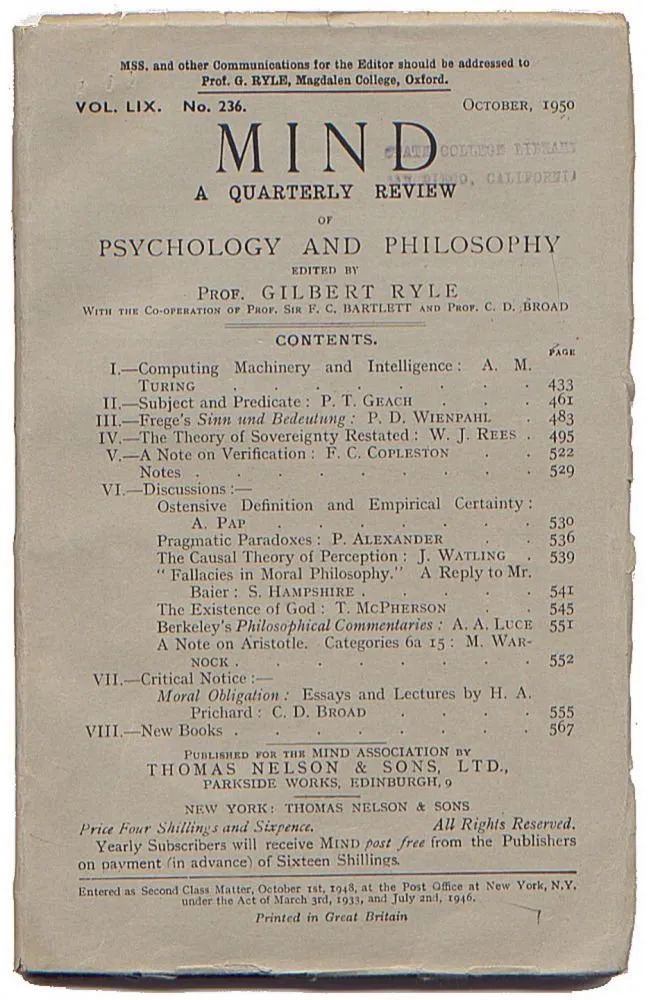The Turing Test was born 70 years ago, is it time to be laid off?
Author: Ringo
2020 is the 70th year of the Turing Test. Although human beings have still failed to build machines that pass the Turing test, this does not affect some voices questioning whether this test that dominates the field of machine intelligence is now out of date.
70 years of "urban legend"
The Turing test is the original concept of artificial intelligence, and it even predates the word "artificial intelligence" itself.
In 1950, the first commercial computer had not yet been sold, and fiber optic cables had to wait four years before they came out. But it was this year that the American computer scientist Turing proposed a set of methods for judging whether a machine is intelligent in his paper called Computing Machinery and Intelligence. Six years after the birth of this method, the term artificial intelligence was proposed.

Picture source: manhattanrarebooks
The Turing test is one of the earliest attempts to answer the question "Can machines think?" It is not complicated. Just separate the human being the tester from the machine being the testee, and then conduct a series of random questions and answers with the machine. After multiple tests, if more than 30% of the human testers cannot be sure that the testee is Humans are still machines, so this machine has passed the test and can be considered as having artificial intelligence.
After its birth, the Turing Test has almost become the "North Star" in the AI world. The earliest chatbots ELIZA and PARRY in the 1960s and 1970s revolved around passing this test. To this day, the Turing test is still shining, continuing to promote the imagination of the field. The Duplex voice assistant presented by Google at its annual development conference in 2019 and the OpenAI GPT-3 language model that turned out in 2020 have all set off heated discussions that they are likely to pass the Turing test.
After Turing published a paper on the Turing test, he also predicted that by 2000, this imitation game would be realized.
Obviously, as human beings who have experienced 2020, we can already deny this prediction. Twenty years have passed, and the entire industry has not yet achieved this goal. Although at this moment, the computing power on your mobile phones is 100,000 times that of Apollo 11. Coupled with cloud computing and high bandwidth, the algorithm can be in a few seconds. Decisions are made within the clock based on massive data.
What puzzles some AI scientists is that the Turing test is less and less like a "useful" target.
Is it out of fashion for real-world applications?
Recently, Rohit Prasad, the chief scientist of the Alexa department of Amazon's voice assistant, shared that as one of the creators of Alexa, he is often asked: "When will Alexa pass the Turing test?"
What troubles him is that the Turing test is certainly a methodology for measuring Alexa's intelligence, but does this ruler have corresponding meaning and relevance?
He found that when artificial intelligence becomes ubiquitous at an unprecedented speed, it becomes more and more obvious that people are more concerned about whether their interaction with machines is useful and smooth (that is, the presence of machines is minimized), and Is there a difference between non-machines and humans. In other words, Turing's statement made 70 years ago is out of touch with the reality.
The Turing test almost completely negates the machine attributes of artificial intelligence, especially rapid calculation and information query, which are the most effective parts of contemporary artificial intelligence.
Rohit Prasad uses a simple scenario as an example to deny that the Turing test emphasizes that it means deceiving humans is of little value: in order for a machine to pass the Turing test, it must answer "Do you know the cube root of 3434756?" or " How far is Seattle from Boston?" When waiting for the question, add a pause.
Even if the true ability of artificial intelligence is that it knows these answers in an instant, in order to be more like humans, it must stop. But the pause is obviously not the maximum use of its skills. In addition, the Turing test does not take into account that artificial intelligence uses sensors to hear, see and feel the external world will become stronger. On the contrary, it is limited to narratives in language.
As one of the person in charge of an AI product, Rohit Prasad's "accusation" is not unreasonable. When artificial intelligence penetrates deeply into people's daily lives, what we expect from them is that these systems can efficiently complete a large number of daily tasks.
If you ask the AI assistant to turn off the lights in the garage, you may not want to have a conversation with it. Instead, you will expect it to complete the request and send back a simple confirmation, such as "OK" or "Complete" to inform you. Even if you talk about hot topics with an AI assistant, or read a story to your child, you want to know that it is an AI, not a human. In fact, "fooling" users by pretending to be human brings real risks.
Although Turing's original vision is still inspiring, what are the limitations of interpreting this test as the ultimate sign of artificial intelligence progress?
Several questions about the Turing test
Turing test is naturally not a perfect product, some of its limitations, Turing himself also discussed in his seminal paper.
Including the machine attributes mentioned above. Since the machine must perform almost the same as a human in QA performance, it is bound to make mistakes. Turing himself in his original paper
This point is clearly stated in the article: “This machine will not try to give correct answers to arithmetic questions. It will introduce errors in a way that deliberately confuses the interrogator.”
Note that here, Turing specifically points out arithmetic problems, but we can extend his logic to other types of errors. There is also a "error" that Turing may not have foreseen, that is, the machine has made an overly clear explanation of the words and deeds made by human intuition. D. Michie, who founded the world's first department of artificial intelligence at the University of Edinburgh, called this type of error "superarticulacy" in his article Turing's Test and Conscious Thought in 1992. Michie's point of view involves the existence of human subconsciousness, which is difficult to be verbalized or formalized, and machines that operate according to programs and codes are just the opposite.
"If a test forces candidates to prove intelligence by hiding intelligence, then people will definitely think that the test is flawed," he wrote.
There is also a critique of the Turing test, which is based on the definition of the type of machine that is the easiest to pass the test, that is, to find which type of machine the Turing test can most encourage. In this view, brute force machines will be the big winners.
Interestingly, most of this sound comes from philosophers, who believe that only checking the output of the machine is a major flaw in the Turing test. Among these criticisms, the most famous theory is "Chinese room argument" by American philosopher John Searle.
In the 1980s, Searle designed this famous thought experiment in his 1980 paper In Behavioral and Brain Sciences, trying to counterattack the design of the Turing test. The specific content of the experiment is, suppose there is a room in which there is a person who does not understand Chinese at all, but there is also a window in the room for this person and him to communicate with the outside world. The connection method is to pass notes. There will also be a set of Chinese character cards and a Chinese rule book in the room, telling the person how to use and combine Chinese character cards. At this point, arrange for someone outside the house to pass a note to this person, with questions written in Chinese attached to the note. Since the person in the house has a perfect rule book, he can correctly choose and combine the Chinese character cards according to the guidance of the rule book, and answer the question fluently while remaining ignorant of any Chinese. Then, the people outside the house have good reason to believe that the people inside must be proficient in Chinese.
The "China House Argument" is actually a critique of the philosopher's functionalism in the field of artificial intelligence.
The other category of doubts from philosophers mainly revolves around human cognition of their own intelligence.
In the Turing test, human testers interact with the machine only through language, which does not include any visual or physical contact. On the one hand, this method of interaction seems fair. We should not label machines as non-intelligent just because they don’t look like humans. On the other hand, is language sufficient to capture all types of intelligence possessed by humans? There is already a lot of evidence that language is not equal to all human intelligence. If these questions are magnified, can the Turing test detect non-human intelligence?
 Image source: Google AI generated
Image source: Google AI generated
These questions are still in the ongoing stage. The existence of these controversies also proves that the Turing test is still very valuable. After all, it is based on such a solid basic fact: language may be the external manifestation of the best intelligence we have.
Is it time to retire this "urban legend" that has inspired the field for 70 years? This is an open question. As the next decade begins, if there are really new challenges that can win the baton of the Turing Test, it would be good news.
References:
1、https://www.fastcompany.com/90590042/turing-test-obsolete-ai-benchmark-amazon-alexa
2、https://academic.oup.com/mind/article/LIX/236/433/986238
About data combat faction
The data practitioner hopes to use real data and industry practical cases to help readers improve their business capabilities and build an interesting big data community.
